Cuttlefish (Sepia) belong to the class of cephalopods. About 30 modern species belong to this order. Cuttlefish are the smallest sizes of all cephalopods. In most species, the length of the body reaches 20 cm, while in small species it is 1.8–2 cm. Only one species — wide sepia — has a length of 150 cm along with the “arms”. Cuttlefish live mainly near the shores in the shallow waters in the tropical and subtropical seas of the Atlantic Ocean and in the Mediterranean Sea.
Structure
The structure of the cuttlefish is in many ways similar to the structure of other cephalopods. Her body is represented by a skin-muscular bag (the so-called mantle) and has an elongated oval shape, slightly flattened and not changing in size (octopuses, for example, easily squeeze into narrow crevices). In cuttlefish head spliced with the body. On the head are large eyes, having a complex structure and a slit-like pupil, and on its front part there is a peculiar beak designed for crushing food. The beak is hidden between the tentacles.
Eight short tentacles-arms and two long grasping tentacles depart from the body of the mollusk, all of which are dotted with suckers. In the calm state, the "hands" of the cuttlefish are folded together and stretched forward, thus giving the body a streamline. Grasping tentacles are hidden in special pockets under the eyes and fly out from there only during the hunt. In males, one of the arms is different in structure from the others and serves to fertilize females.
On the sides of the body of the cuttlefish are fins, elongated in the form of a border, which are a means of promoting movement. The cuttlefish accelerates its movement in the water through several sharp movements. It draws water into the compression chamber, which is compressed to release water from the siphon under the head. The clam changes direction by turning the hole of this siphon. The cuttlefish differs from other cephalopod mollusks by the presence of an internal calcareous shell in the form of a wide plate that covers its entire back and protects internal organs. The inner shell of the cuttlefish is constructed of aragonite. This substance forms the so-called "cuttlefish bone", which is responsible for the buoyancy of the mollusk. The cuttlefish regulates its buoyancy by the ratio of gas and liquid inside a given bone, which is divided into small chambers.
The remaining internal organs in cuttlefish are arranged in the same way as in other representatives of cephalopods. This animal has three hearts: one heart for two gills and one heart for the rest of the body. The cuttlefish has a blue-green blood, because of the hemocyanin pigment in it, which is saturated with copper-containing proteins, which can preserve oxygen for a long time, preventing the mollusk from suffocating at great depths. Also cuttlefish have an ink bag that produces a very large amount of ink, compared to other cephalopods. The ink has a brown color and is called sepia. Having such a protective agent, the cuttlefish uses it directly for protection as the last resort.
The color of the cuttlefish is very changeable. In the structure of their skin, there are three layers of chromatophore (cells of the dye pigment): on the surface is a light yellow layer, the middle one is an orange-yellow layer and a dark layer located under the two previous layers. The transition from one shade to another is regulated by the nervous system and occurs within a second. For a variety of colors, the complexity of the pattern and the speed of its change, these animals have no equal. Some species of cuttlefish can luminesce. Color change and luminescence is used by the clam for masking.
Breeding
The cuttlefish live one at a time, very rarely in small flocks, and lead a sedentary lifestyle. During the breeding season, they form large clusters and can migrate. Usually, cuttlefish swim a short distance from the bottom, tracking down prey, seeing it, they freeze for a moment, and then with a swift movement they catch up with the victim. When cuttlefish are in danger, they sink to the bottom, and with a wave of fins fall asleep themselves with sand. To the liking of these animals are very careful and fearful. Cuttlefish hunt in the daytime and eat various fish, shrimps, crabs, clams, worms - almost all organisms that move and do not exceed them in size. To increase the effectiveness of hunting, the mollusk blows a stream of water from a siphon into the sand and catches small animals washed with a stream. Small animals cuttlefish swallow whole, large - butchered.
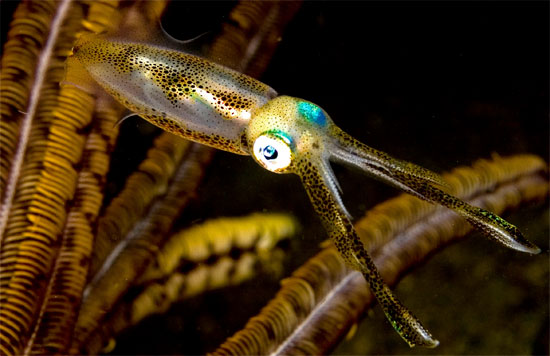
Cuttlefish have many enemies, since their low speed makes them vulnerable to predatory fish. Dolphins, sharks and rays eats these mollusks. Cuttlefish are sometimes called "chameleons of the sea" for their good masking to the color of the environment. While hunting or fleeing predators, they rely more on their ability to disguise than on their protective ink.
Cuttlefish are dioecious animals. They multiply once in a lifetime. The male treats the female with quivering tenderness, swimming nearby, he strokes her tentacles, while both flash with bright colors. The male introduces sperm to the female with a modified tentacle, eggs are fertilized when they are laid. Cuttlefish eggs are black and look like bunches of grapes; when laying, females attach them to underwater vegetation. Some time after spawning, the adults die. Juveniles are born completely formed, having an ink bag and inner shell. Already from the first moments of life, they can apply ink. Cuttlefish grow quickly, and live for long - only 1-2 years.
Since ancient times, people have hunted on cuttlefish because of their tasty meat, which is used in Mediterranean and Chinese cuisine. The crushed shell is part of a number of toothpastes. In the old days, the ink liquid of cuttlefish was used for writing, and in a diluted form for the preparation of a special paint for artists - sepia. Therefore, people are obliged to cuttlefish countless masterpieces of painting and writing.
Niramin - Dec 12th, 2016
The cuttlefish lives mainly in shallow water in the tropical and subtropical seas of the eastern hemisphere. A huge number of these representatives of cephalopods are found in the Mediterranean, where they are about 100 species.
The cuttlefish looks like a squid, simultaneously resembling a stingray and an octopus. It has a flattened body with a fringe border on the sides and ten short tentacles with suckers that the animal can retract into special containers located on the head. With the help of tentacles, the cuttlefish hunt, throwing them out and sticking to the victim.
This marine inhabitant is able to move with the help of fins, and also uses a jet method, due to the presence of a jet funnel.
Cuttlefish are distinguished by a developed nervous system and excellent eyesight. In addition, this representative of cephalopods has numerous photosensitive cells located on the surface of the body. Thanks to these cells, the cuttlefish is able to perfectly disguise itself in the environment and change its color in literally 1 to 2 seconds. In case of particular danger, it quickly floats away, leaving behind a dense cloud of ink.
Masking, the cuttlefish hides from enemies, and at the same time imperceptibly lurks prey. Throwing sand on himself with the help of fins, this master of disguise falls on the bottom, assuming its color and shape, and small sea creatures passing by are at risk of falling into its tenacious tentacles. The cuttlefish is not always passively waiting for its prey. Using her jet funnel, it slowly swims and blurs bottom mud and sand, under which the prey hides. In some cases, hunger makes this leisurely inhabitant of shallow water even chase after its victim.
The cuttlefish feeds on small inhabitants of the sea: shrimps, crustaceans, small fish, mollusks. Thanks to the taste buds located on the tentacles, the cuttlefish first tastes its dish, determining whether it meets its gastronomic requirements.
Interestingly, for centuries, mankind has used cuttlefish ink for writing and drawing.


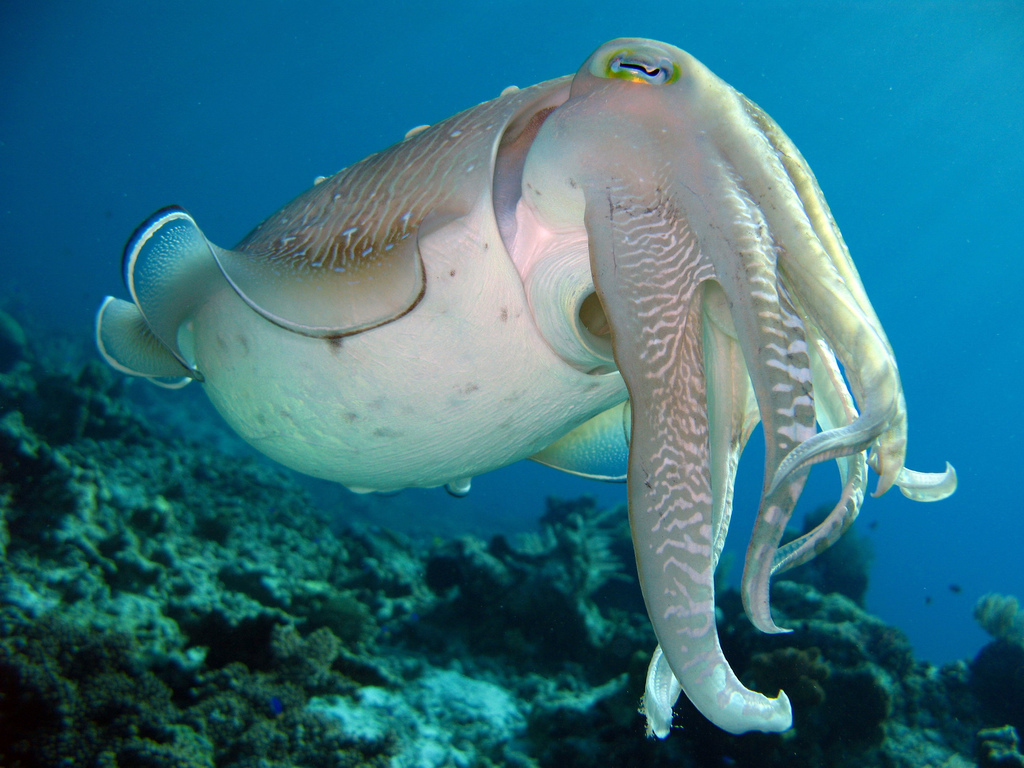


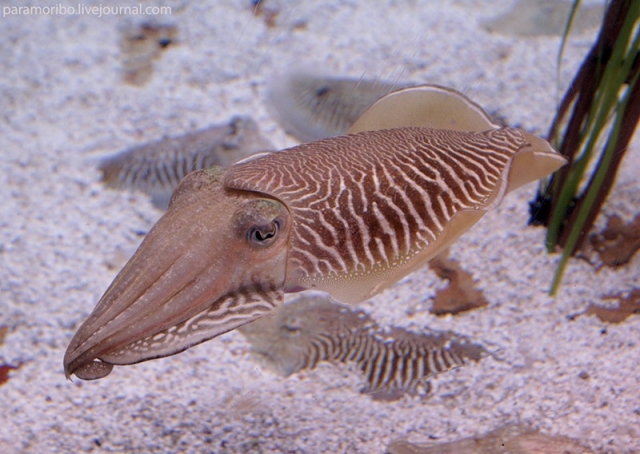


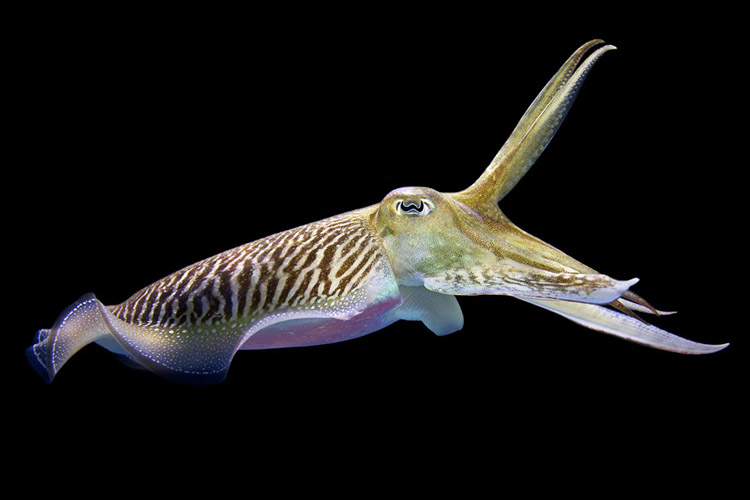

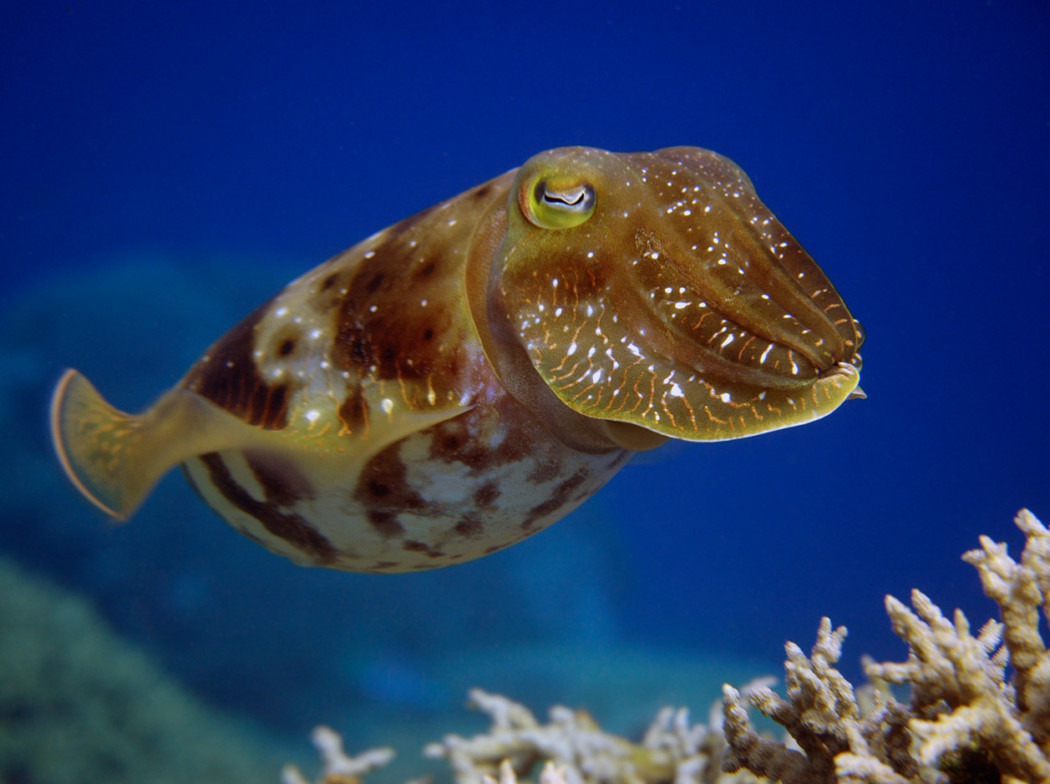
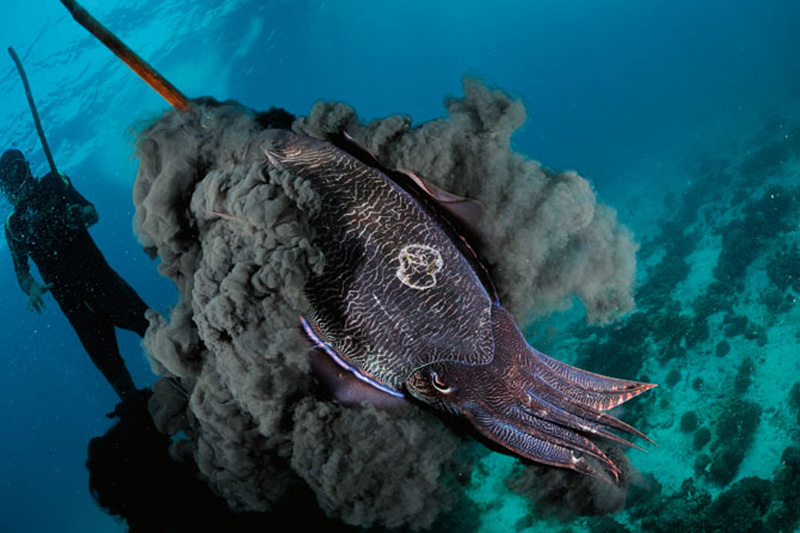 Photo: Cuttlefish shoots an ink bomb.
Photo: Cuttlefish shoots an ink bomb. 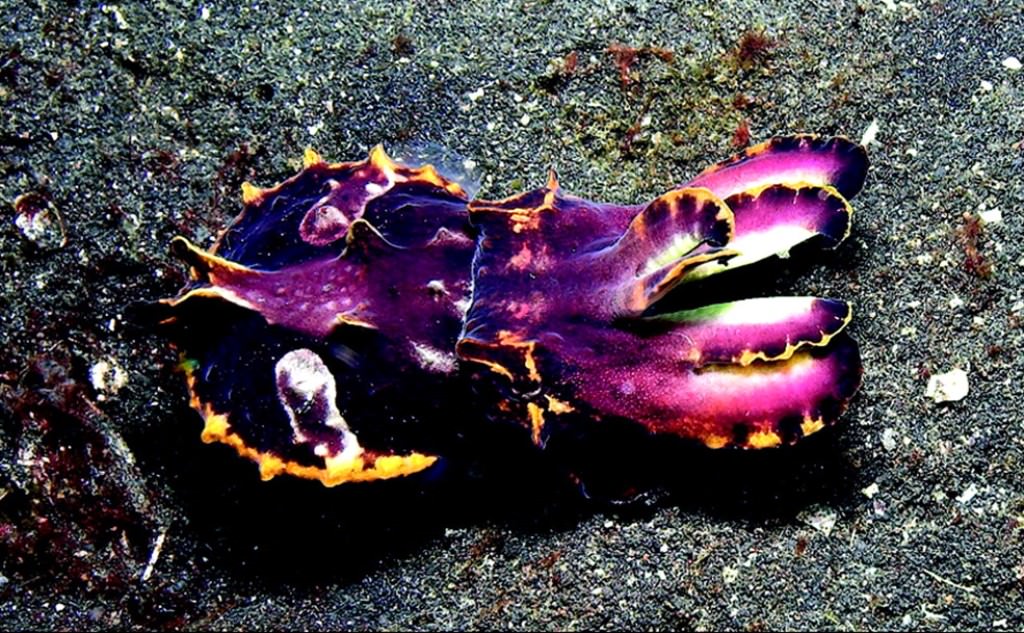 Photo: Painted cuttlefish - poisonous.
Photo: Painted cuttlefish - poisonous. 
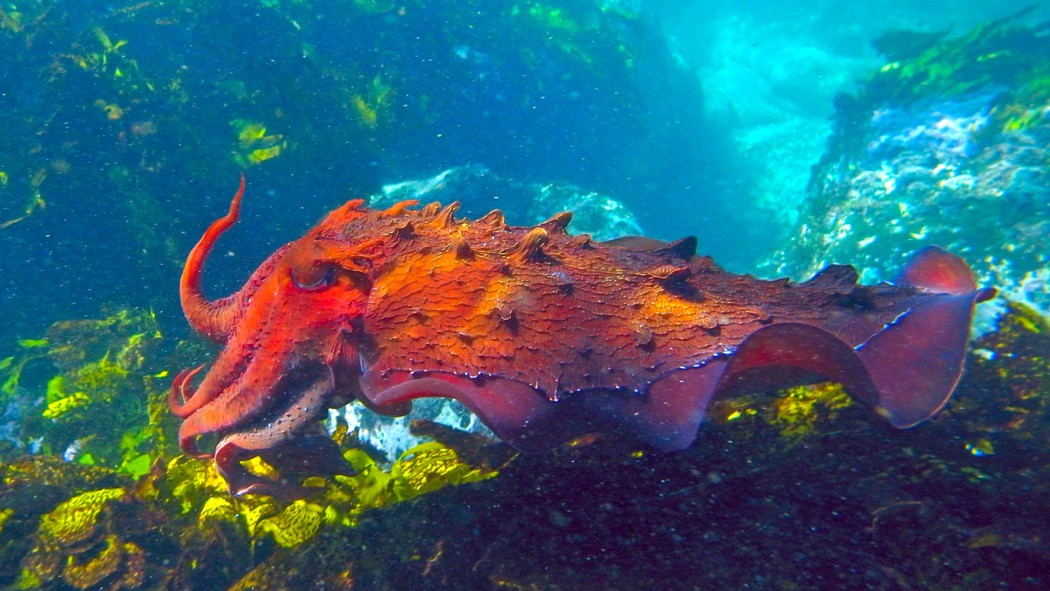 Photo: Australian giant cuttlefish.
Photo: Australian giant cuttlefish. 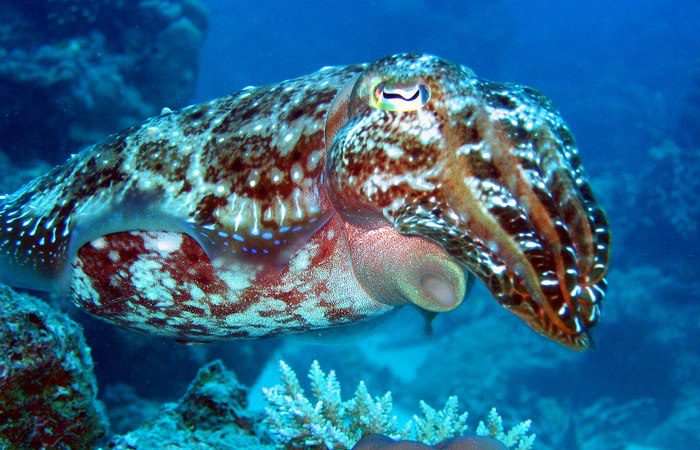
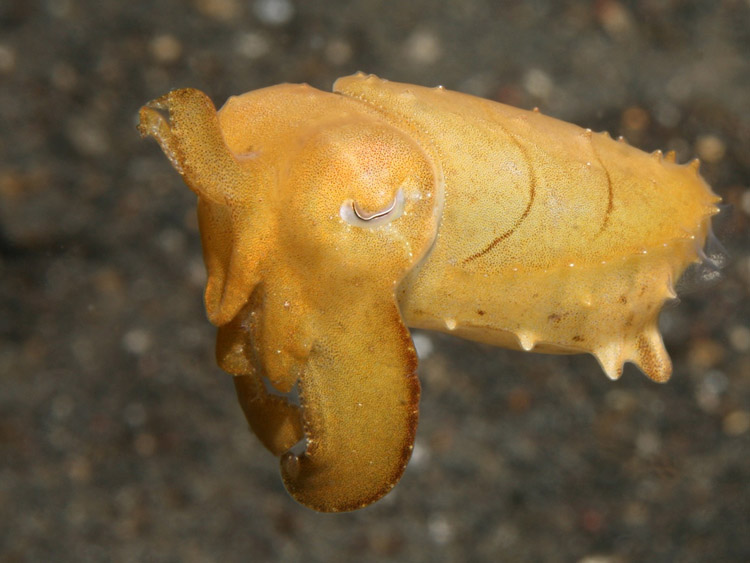
Video: Cuttlefish (Latin Sepiida)
Video: Cuttlefish - the universal spy - octopus.
Video: Marriage games of cuttlefish.wmv
Video: Cuttlefish. in MARINE AQUARIUM at Chistye Prudy
Sepia vulgaris, or medicinal cuttlefish, is active at night. She hunts fish and small crustaceans. In the afternoon, sepia changes its color and disappears in the gorges of underwater rocks.
& nbsp & nbsp Type of - Shellfish& nbsp & nbsp Class - Cephalopods
& nbsp & nbsp Row - Cuttlefish
& nbsp & nbsp Rod / Species - Sepia officinalis
& nbsp & nbsp Basic data:
DIMENSIONS
Body length: 30 cm
Tentacle Length: tentacles used for hunting can reach 50 cm.
Reproduction
Marriage period: spring and summer.
Number of eggs: about 300.
LIFESTYLE
Habits: keep in small flocks that attracts different predators: dolphins, sharks and stingrays.
Food: fish, crustaceans.
RELATED SPECIES
About 100 species belong to the family of real cuttlefish. The size of these animals is from 1.8 to 150 cm. Cuttlefish belongs to the class of cephalopod mollusks, and its close relatives are nautilusf and argonauts.
& nbsp & nbsp Sepia ordinary belongs to the class of cephalopods, that is, it is one of the most developed representatives of mollusks. Nature provided her with a flat body, mobile tentacles, well-developed eyes and amazing abilities. Fleeing from danger, sepia can instantly change the color of the body and swim back.
FOOD
& nbsp & nbsp Sepia hunts at night. She catches fish and crustaceans. Since sepia has a well-developed vision, it freely covers the entire space and easily sees the prey. Sepia moves slowly, with the help of a mantle, the wavelike movements of which push it forward. While moving, the sepia's limbs are pointing forward. When the prey is at the right distance, sepia throws forward two long tentacles with maces at the ends and clicks the victim.LIFESTYLE
& nbsp & nbsp Normal sepia prefer shallow water, usually with a sandy bottom. In the afternoon they lie on the bottom. With a change in the color of the pigment cells, the body acquires the color of the environment. The protective coloration perfectly masks ordinary sepia. Often, sepia to mask fins throw sand on their backs to become completely invisible. At night, the animals go hunting. Their inner calcareous sink (sepion) has a porous structure. The voids are filled with air, which reduces the weight of the animal.Reproduction
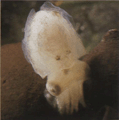 & nbsp & nbsp Ordinary sepia - heterosexual animals. They breed in coastal shallow water. During the mating season, males on the body appear clear violet and purple transverse stripes. When another sepia approaches the male, he raises the hectocotyl. This body is adapted for storing and transferring semen. If another sepia does not repeat the gesture of the male, then the individual that approached is the female. The male fertilizes her by placing spermatophores into the seminal receptacles of the female with the help of a hectocotyl. After some time, the female lays about 300 eggs. Sepia masonry look like grape womb. Small sepia hatch from eggs.
& nbsp & nbsp Ordinary sepia - heterosexual animals. They breed in coastal shallow water. During the mating season, males on the body appear clear violet and purple transverse stripes. When another sepia approaches the male, he raises the hectocotyl. This body is adapted for storing and transferring semen. If another sepia does not repeat the gesture of the male, then the individual that approached is the female. The male fertilizes her by placing spermatophores into the seminal receptacles of the female with the help of a hectocotyl. After some time, the female lays about 300 eggs. Sepia masonry look like grape womb. Small sepia hatch from eggs.FEATURES OF THE DEVICE
& nbsp & nbsp Sepia uses several amazing ways to trick the enemy or attract loot. During the hunt, sepia changes color and blends in perfectly with its surroundings. When several sepia hunt together, the animals move in concert and at the same time change color. Fleeing from the enemy, sepia closes the hole in the mantle, reduces the strong muscles of the walls of the mantle and drastically releases water from its body through a narrow funnel. This device, like a jet engine, pushes it forward. Sharp changes in speed and direction of movement are possible due to a change in the angle of rotation of the funnel. It confuses the enemy. At the slightest danger, sepia also uses ink, forming a veil that allows it to escape.& nbsp & nbsp
DID YOU KNOWN THAT ...
- Sepia, attacked, throws out ink at such a rate that it can paint 20 cubic meters of water within a few minutes.
- Wounded or weakened sepia often casts ashore. Why this is happening is still unknown.
- If sepia loses one of its tentacles, a new one soon grows in its place.
- During the mating season, sepia females glow brightly enough. They have luminous organs.
- In sepia ink, people have been writing for hundreds of years. In addition, for centuries, they have been used to produce brown dye, which is called sepia.
- Sepias have a well-developed nervous system and brain.
SPECIFIC FEATURES OF SEPIA
& nbsp & nbsp Leather: contains hundreds of cells with pigment that stretch and shrink. Thanks to these cells, the cuttlefish can change color within a few seconds. The color change is important when disguised and during the mating season.& nbsp & nbsp Limbs: eight shorter tentacles are the organs of touch that give information about the world around them. They have 2-4 rows of suckers with which the cuttlefish attaches to objects and holds food at the mouth opening. Two tentacles are used to catch prey. One of the hands of the male (hectocotyl) is adapted to transfer spermatophores (containers with sperm).
& nbsp & nbsp Mantle: on both sides it surrounds the body, serves for swimming and changing the direction of movement.
& nbsp & nbsp Sink, or sepion: this solid calcareous plate, like a shield covering the body of the cuttlefish. Consists of several layers.

PLACES OF LIVING
Sepia ordinary lives in the Mediterranean, is also found in the northeastern part of the Atlantic Ocean, in the Baltic Sea and the English Channel.
PRESERVATION
Sepia has long been a target. For many centuries, people used to write its ink. In addition, the taste qualities of sepia meat are highly valued. In our days, the mind does not threaten the disappearance.
Friends, today we will again go to the underwater kingdom and get acquainted with its very unusual and interesting inhabitants, cephalopods in the selection of squid, octopus, cuttlefish pictures, photos, videos. Squids are perhaps the most famous among them and are most often found in our lives, usually in cooking, and many even like these unusual tastes of the clam. But few people know about the life of a squid; let’s shed some light on this question today. Squids belong to the order of decapods of cephalopods, they have four pairs of tentacles and one pair of prehensile elongated, equipped with chitinous rings, which over the years turn into hooks, representing a rather formidable weapon.
They are not large in size, an average of 25-50 centimeters, we like to eat them, but there is also a squad of giant squid, the dimensions are not joking, the largest squid officially registered by science was 17.4 meters in length back to the tip of the tentacles, what would brighter imagine how much it is, about the average five-story building, and it weighed about 500-600 kg. This is a colossus, it is even difficult to imagine such a giant, these are the largest representatives among the mollusks living on the earth.

Squids have a dense body, a cylindrical shape, a pointed plate on the back looks like an arrow. Squids are excellent swimmers, they can move under the water with the help of a fin, as well as in a reactive way. They collect water in themselves and push it through a narrowed nozzle, while many small squid species develop enormous speed, up to 50 km / h and only a few of the high-speed inhabitants of the oceans can compete with them, such as dolphins, swordfish, tuna fish. At the same time, moving away from predators, squid are able to jump out of the water and fly in the air up to 40-50 meters, often during this flight, they find themselves on the deck of a ship or schooner, the sailors call them flying squid. In addition to speed, jet navigation method makes it possible to make sharp maneuvers, by changing the direction of the nozzle.

Squids live in all oceans and at all latitudes, from the Arctic and Antarctic to equatorial waters. Squid is also found in our northern seas of the Arctic Ocean basin, but they are small in size and many species are almost colorless. Large squid species live at great depths of the order of 500-600 meters, possibly up to a kilometer and for this reason science has poorly studied, the same species that come to us at the dinner table, most often live in shallow depths, offshore sections of the ocean and serve a great object for industrial fishing.
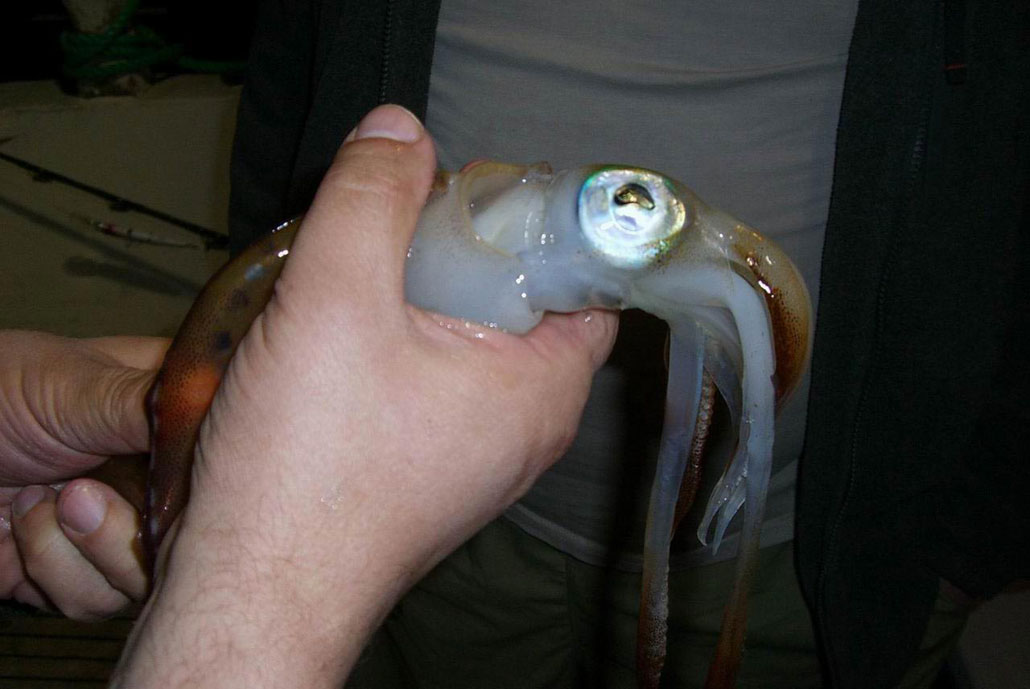
Squids do not live long, from 1 to 3 years, giant and colossal squids live much longer. A distinctive feature of these mollusks is the ability to throw out an ink cloud in case of danger, which disorients the predator and enables squid to escape from pursuit. Another interesting fact, the blood of the squid is blue, this color is due to the presence of copper in the blood.
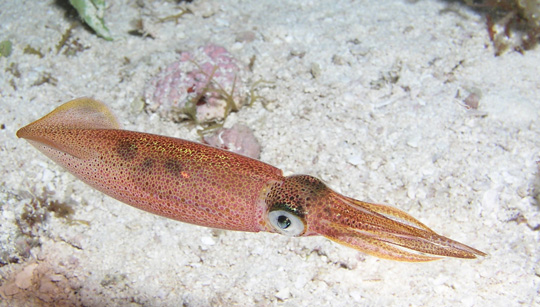
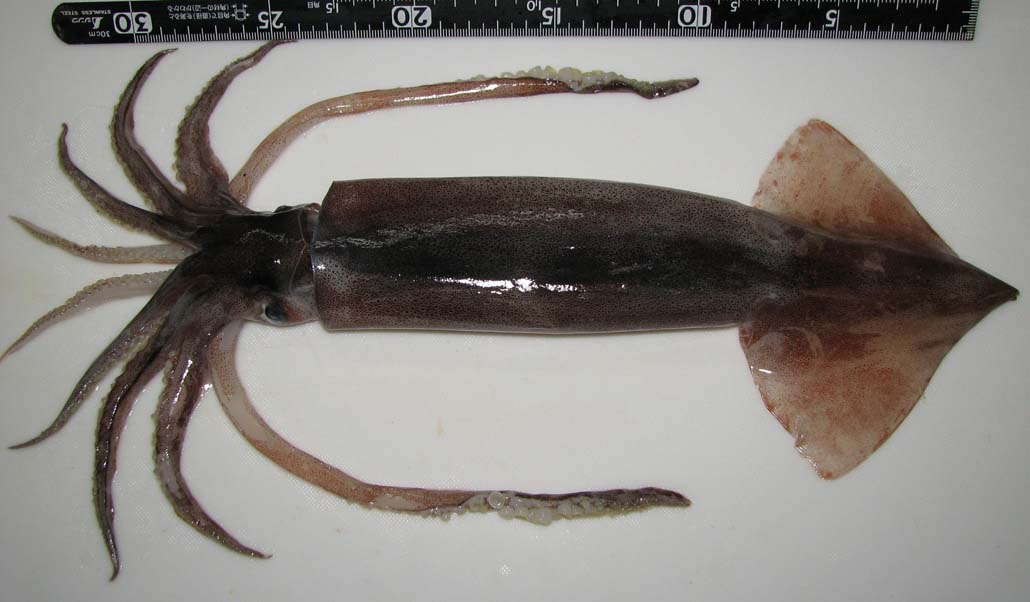

Giant or colossal squids inhabit the temperate and subtropical waters of all oceans. They are found at a huge depth of a kilometer. These are the largest representatives of mollusks, they are not as fast as smaller squids, but they don’t need speed at all. A distinctive feature are their eyes, they are very large, may be more than 20 cm in diameter and are the largest organs of vision on earth.

In the environment, an adult giant squid has only one enemy: the whale is a sperm whale who is able to dive up to a kilometer deep and stay there for a long time while holding his breath. Of course, squid stubbornly resist, but the forces of the whale and squid are incomparable, the whale weighs about 40-50 tons, and the large squid has a maximum of 400-500 kg, agree the outcome of the meeting is predictable in advance. And the whale remains on the head and body only scratches from the hooks on the tentacles and traces from the squid suckers.

Can giant squids be a threat to humans? Theoretically, yes, but almost no such cases were recorded, because squids live at a great depth and cannot fundamentally meet a person. And if the giant squids are on the surface, then this is either a sick representative of the species, or already dying, that is, again, he will not be able to harm the person.
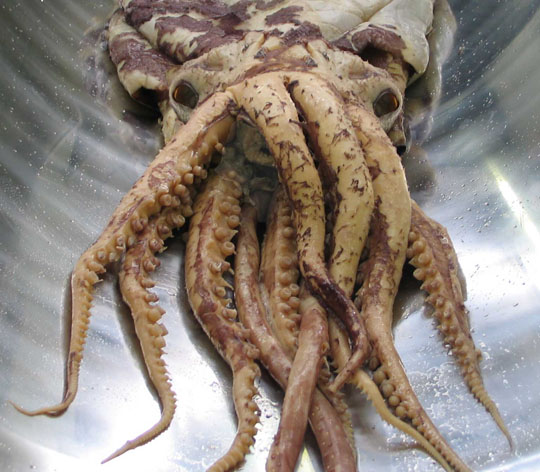
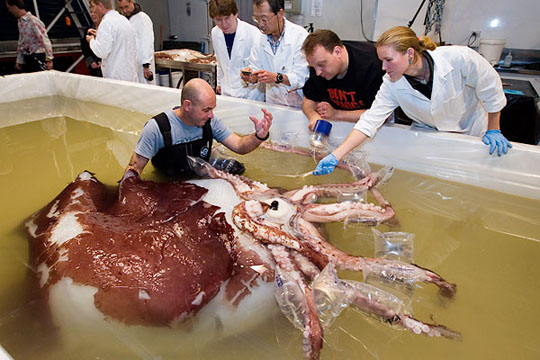


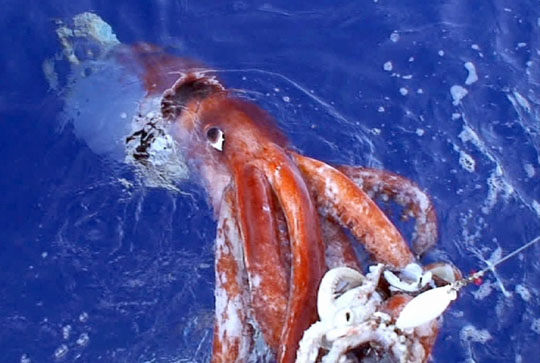
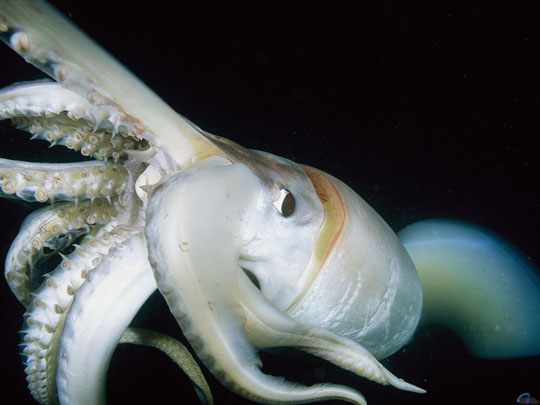
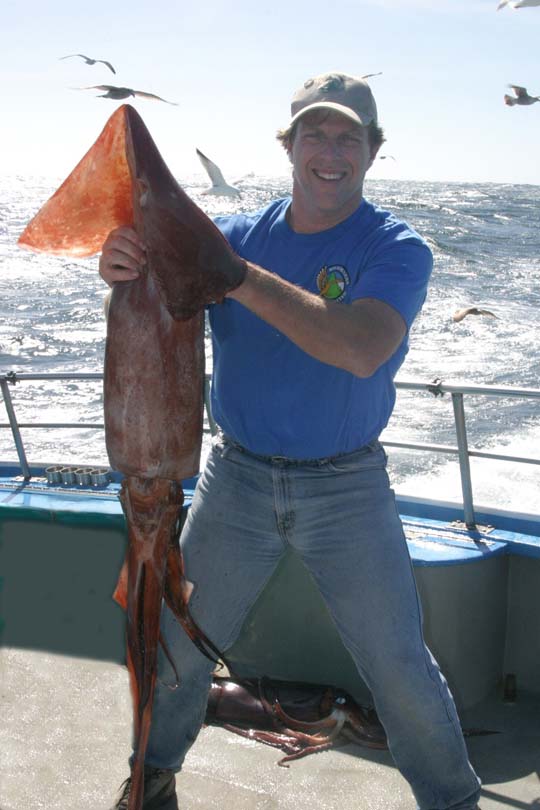
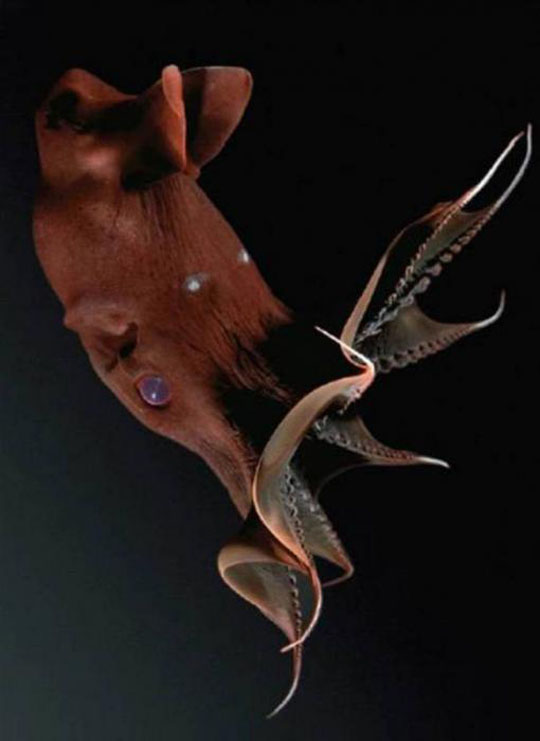
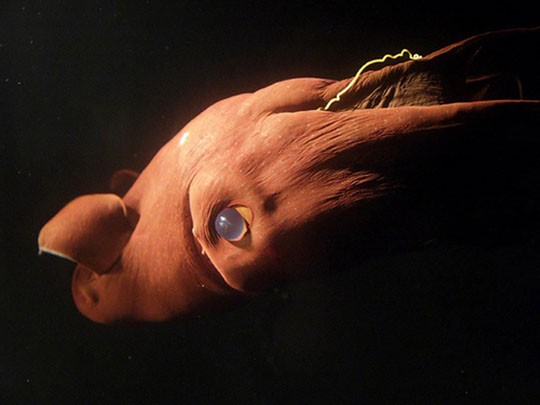
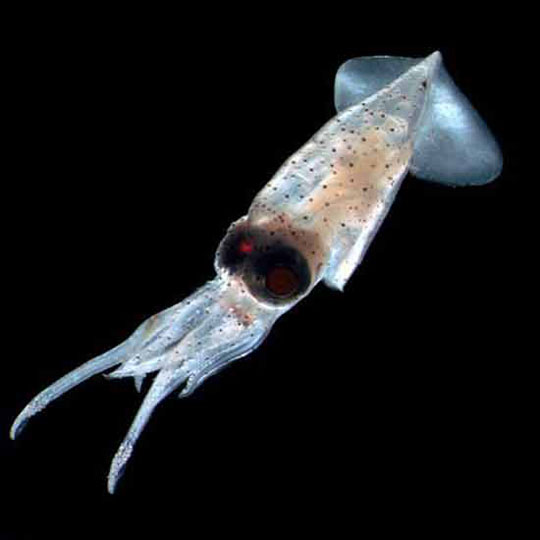
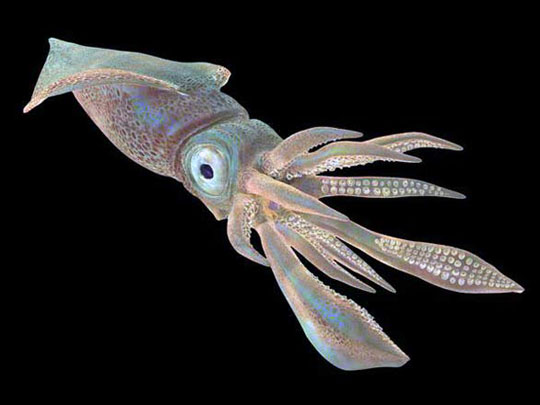
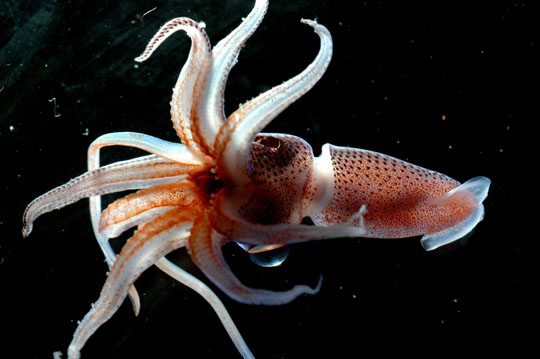


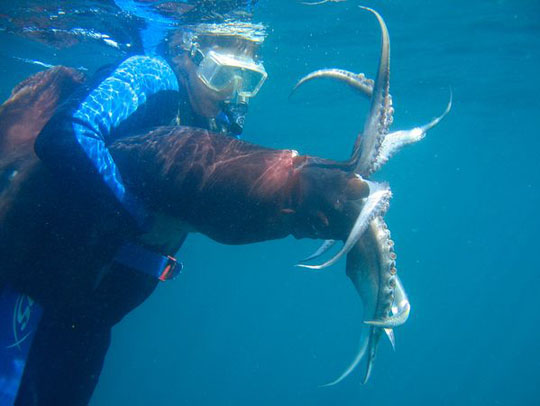
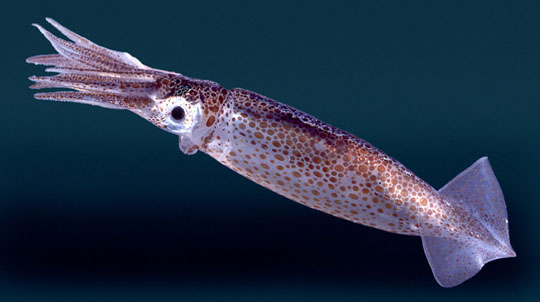
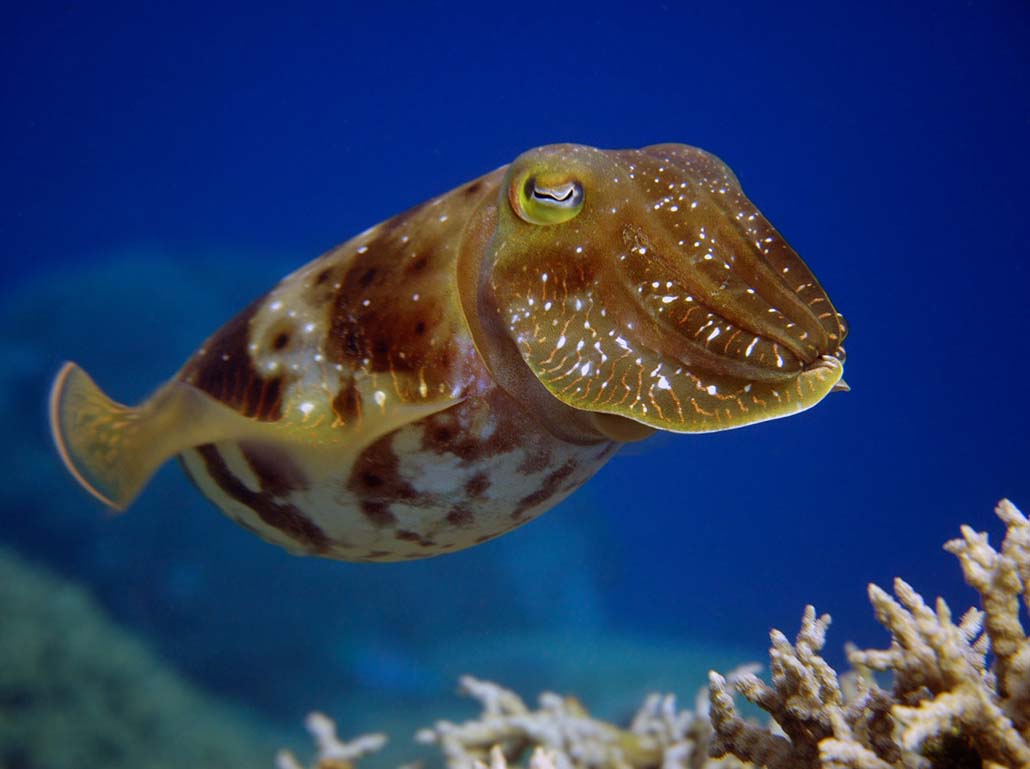
The cuttlefish, like squids, is a cephalopod mollusk, its body is slightly flattened and trimmed along the perimeter with a cartilaginous flipper, which stretches along the entire body on the sides and only at the very end of the back is being eroded. Unlike other members of the squad, inside the cuttlefish there is a hard lime sink that looks like a plate. The cuttlefish swims mainly due to its lateral fins, but it can also use the jet style, most often this happens only in the case of salvation when a predator attacks and abruptly evading pursuit.

Most often, the cuttlefish lives in shallow depths and prefers a sandy bottom, the style of hunting is passive in it, it lies on the bottom, is masked with sand with the help of a fin on the sides, and sits in ambush, waiting for the sailing victim. According to its size, the cuttlefish is the most modest representative of the genus, its average length does not exceed 50 cm. It is in the largest species, and the most common species of cuttlefish is not more than 20 cm in length, there are smaller representatives up to 2 cm in length. Habitat Atlantic Ocean and the Mediterranean Sea, and off the coast of the Americas it is not found.
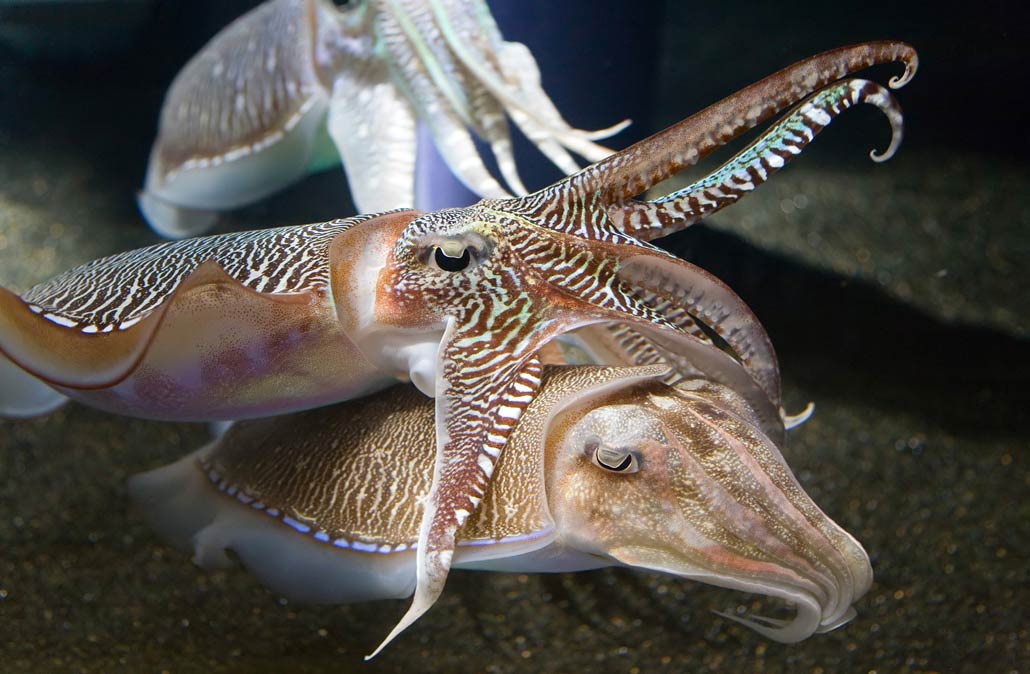
The cuttlefish feeds on krill, small crustaceans, small fish, larger species can also eat crustaceans, crabs, and bivalve mollusks. At the same time, they easily break the shell with their strong beak, like a parrot's beak and with a sharply honed tongue, crush the prey for more convenient use.
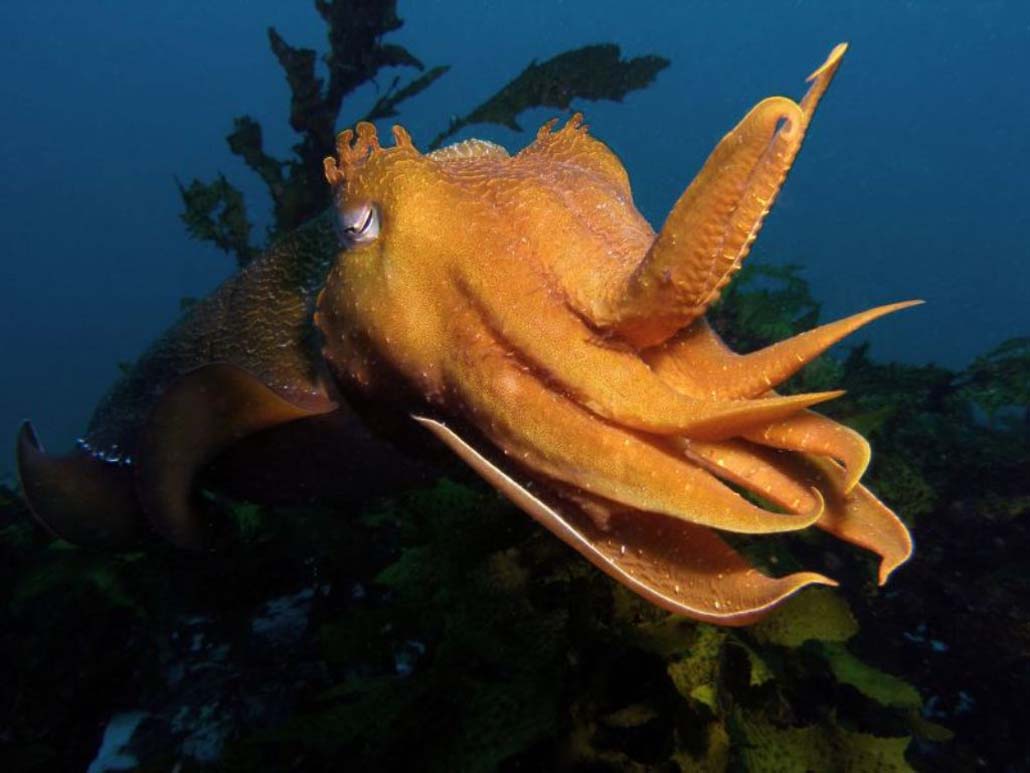
Cuttlefish has some bright properties. Firstly, the cuttlefish is the best masker in the world, it easily changes its color to the color of the soil, or depending on the mood. Moreover, the pattern on the body can be varied both in shape and geometry, and in color, and the cuttlefish changes its color in just a second or two. Here, no one inhabitant of the earth can compare with it, even the well-known chameleon with its unique capabilities pales in comparison with this mollusk.
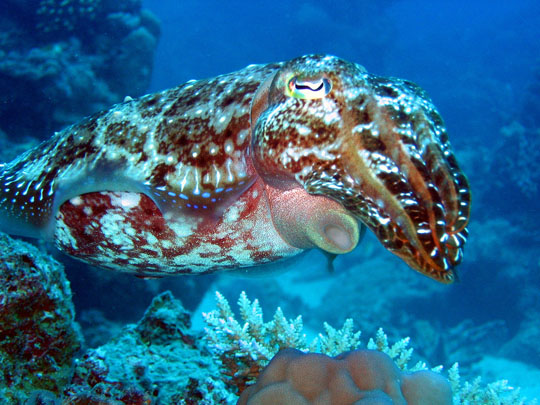
Just cuttlefish has the largest supply of ink fluid among their relatives, and uses this unique ability to escape the pursuit of predators. And the cuttlefish has a lot of enemies: sharks, rays, dolphins, sea lions, seals, large predatory fish, so it’s necessary to put ink into the action very often. The cuttlefish throws a cloud of paint out of the ink bag, and including the jet engine, disappears abruptly from the attacker's field of vision.

Another interesting fact is the beautiful mental abilities and memory of the cuttlefish. It has been observed that since childhood, the cuttlefish remembers its offenders who tried to attack and kill her, and when she grows up, she prefers to hunt for this kind of animals, as if in the form of revenge and protection of their future descendants from such attacks.

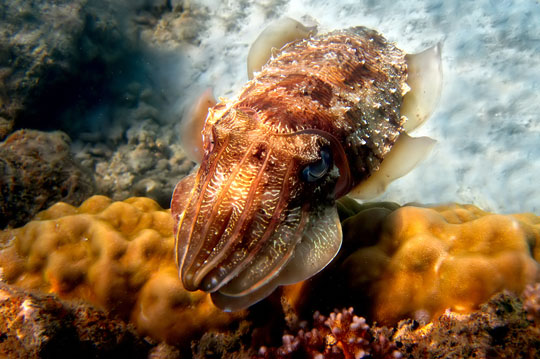
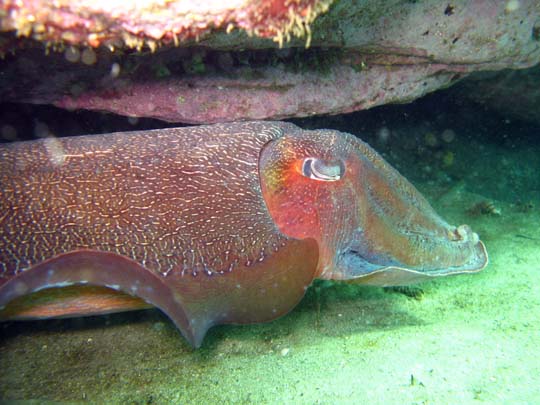 Cuttlefish photo
Cuttlefish photo 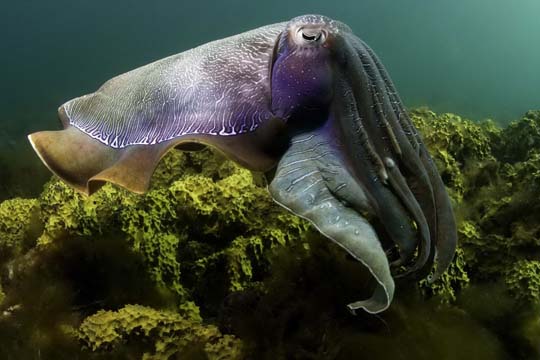
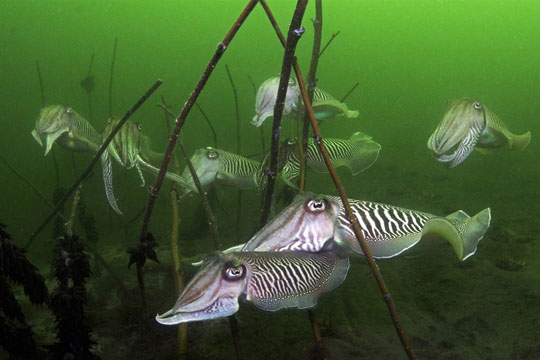
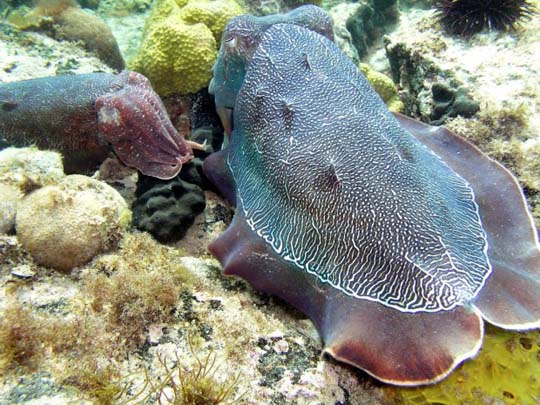 Cuttlefish
Cuttlefish 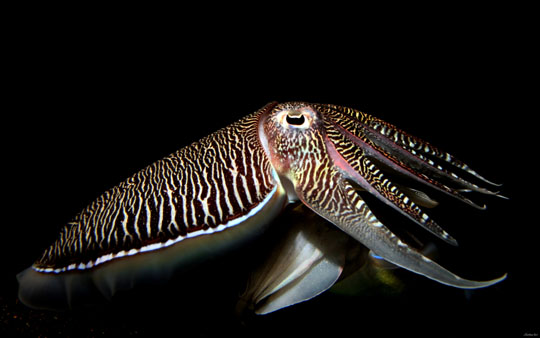
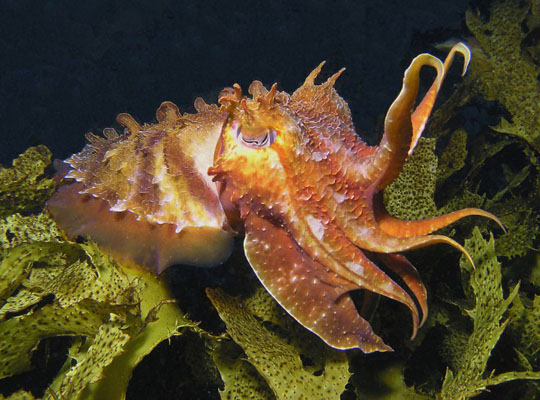 Cuttlefish pictures
Cuttlefish pictures 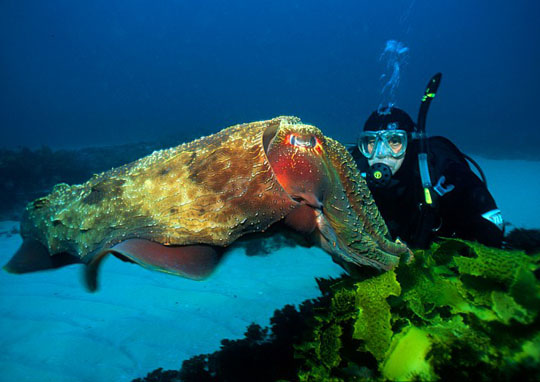
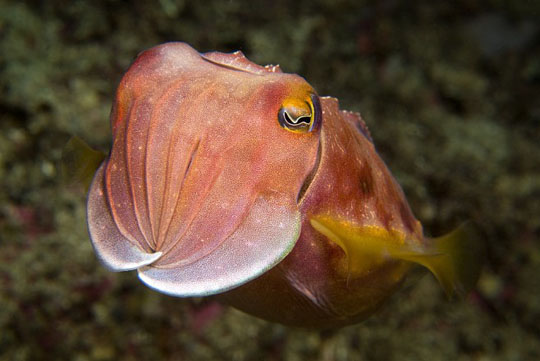

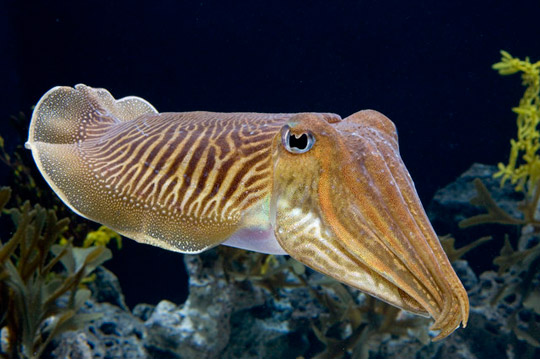

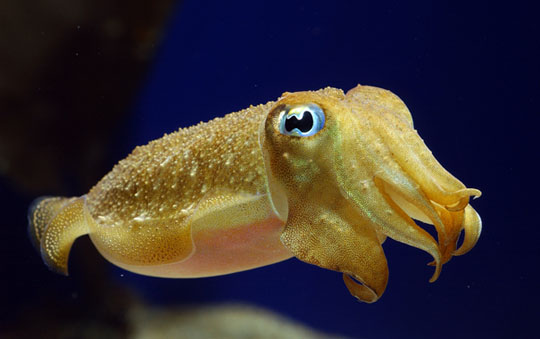
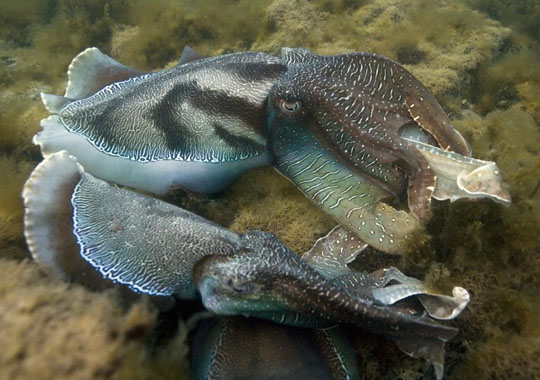 Cuttlefish
Cuttlefish 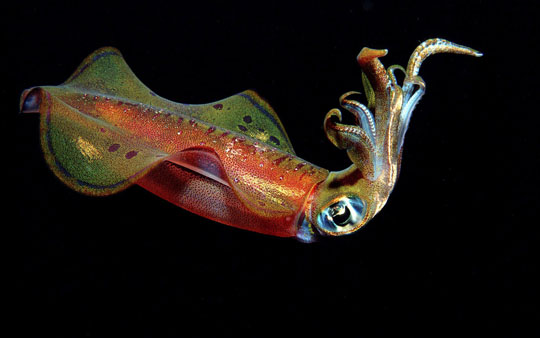

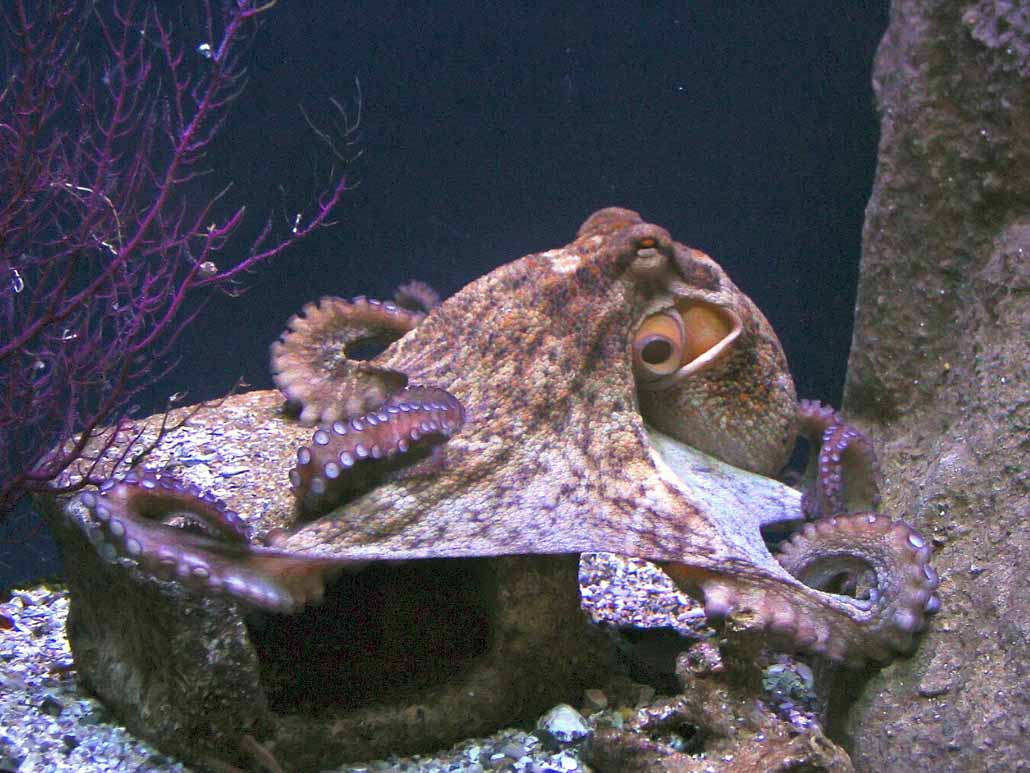
The next representative of the order of cephalopod mollusks is the octopus, by name, it is probably clear how it differs from squid and cuttlefish, it has eight legs (arms, tentacles, any name is applicable in this case). They are symmetrically located around the perimeter of the head, and in the center is the oral opening. Octopuses do not have any hard organs inside their bodies, with the exception of the beak, which is very similar to the beak of a parrot. Due to the absence of a rigid inner frame, octopuses can squeeze their bodies into very narrow holes, which are many times smaller than the entire body.
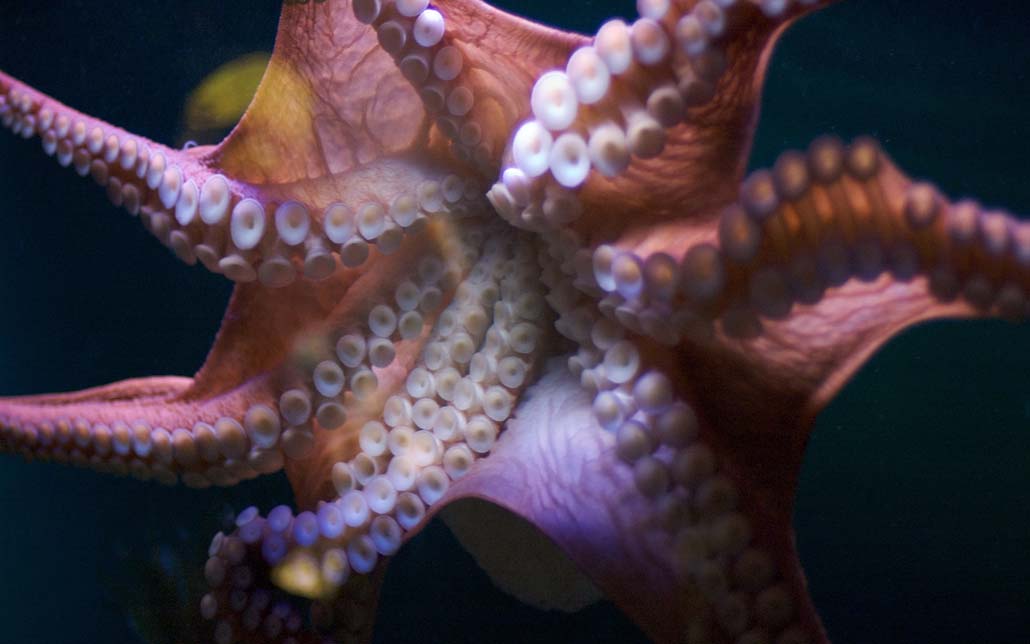
The octopus tentacles are equipped with two rows of powerful suckers, each of which can hold a load of up to one hundred grams, as well as they are interconnected by a thin leathery membrane. Octopus moves using the crawling method, using its tentacles and suckers, and they can also swim by using thrust, like its other relatives. But the speed of movement is relatively not high and octopuses cannot maintain it for a long time, for this reason they prefer to sit in shelter, in order to avoid predator attacks.

Octopuses prefer to settle at a shallow depth, most often on a rocky bottom, where there are enough different crevices, caves and other natural shelters. They also hunt from ambush, waiting for their prey in a secluded place and throwing their tentacles to catch prey with lightning speed. Further, with their powerful beak, they break any protective shell. Octopus feed on shrimps, crayfish, crabs, fish, of course, if you can catch it.

Octopuses have some interesting features, they, like all relatives, can change their color and disguise themselves as the surrounding area, the octopus has three hearts, one drives blood all over the body, and the other two supply blood to the gills, by the way, the octopus can stay for a long time outdoors without harm to your body. He also has ink bags and, in case of danger, the octopuses let their paint go. Another interesting point, octopuses can throw away their tentacles, as some lizards do, and by sacrificing a limb, save their body from destruction. By the way, the limb regenerates over time and is restored in its original form.

Octopuses are very clean and their homes are regularly washed using their jet engine, and food remains, shells and shells are taken to a special rubbish heap away from the shelter. It is noticed that the color of the octopus can be determined by coloring, if it is very frightened, it becomes white, and at the moments of anger and rage, its skin becomes reddish. It is also an interesting fact, the octopus has excellent eyesight, and the pupils are rectangular in shape. Octopuses are the wisest representatives among mollusks, they are amenable to training and are able to perform certain tasks, distinguish objects, recognize people with whom they often communicate, and even become tame.
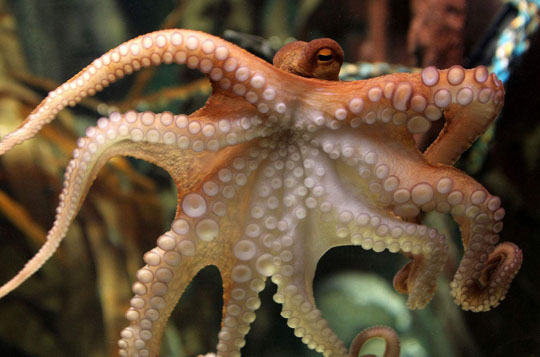
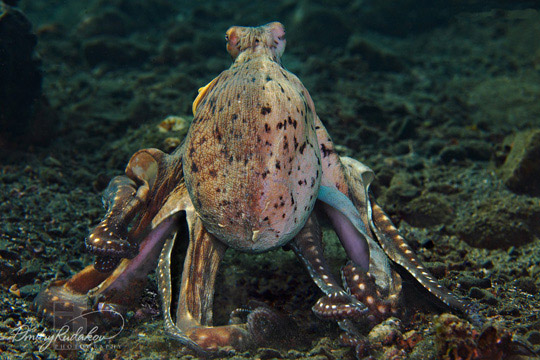


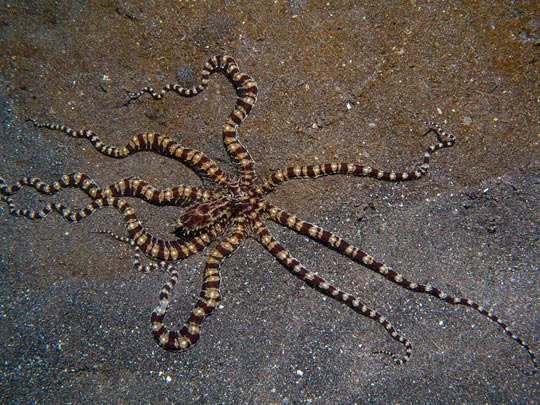
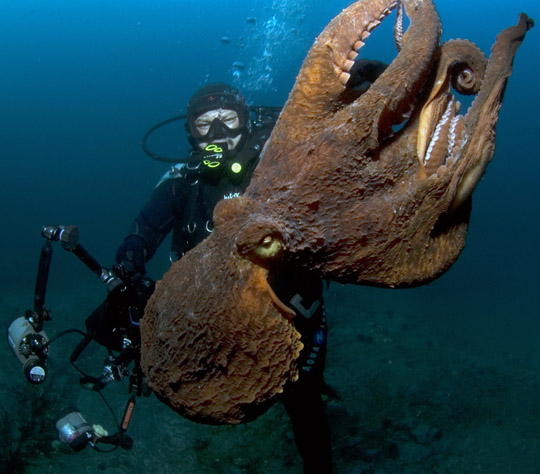
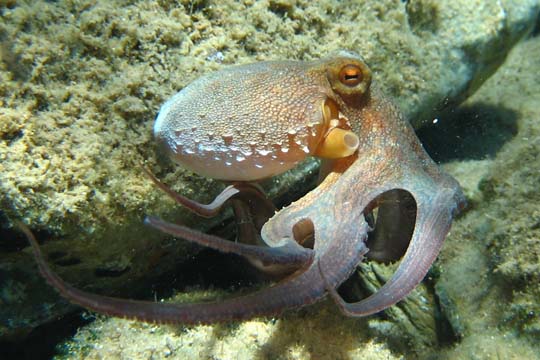

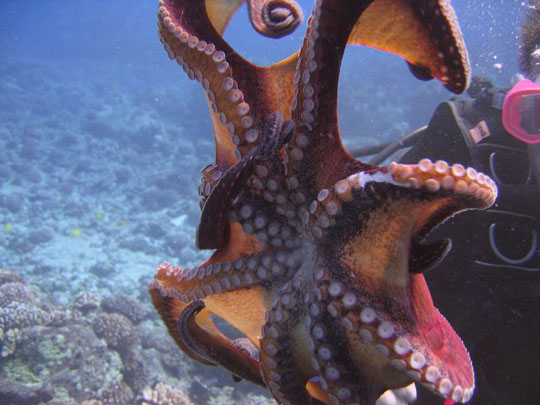
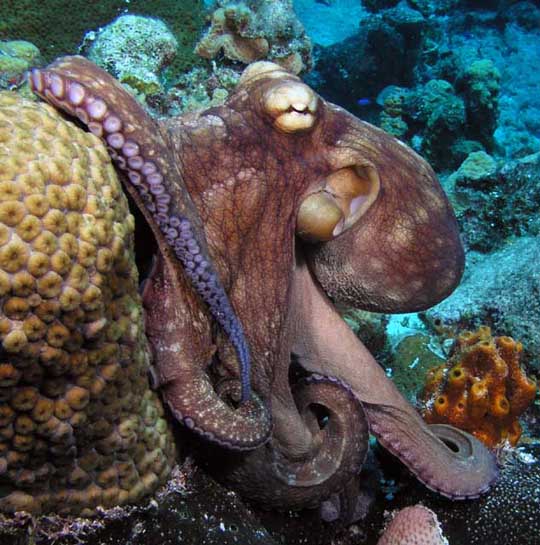
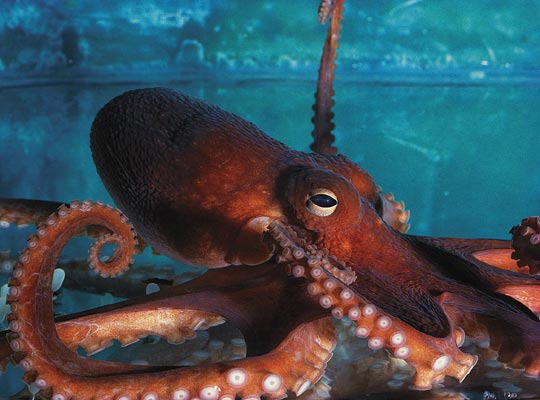
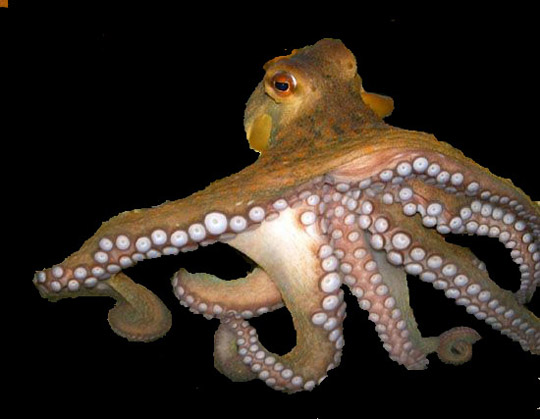
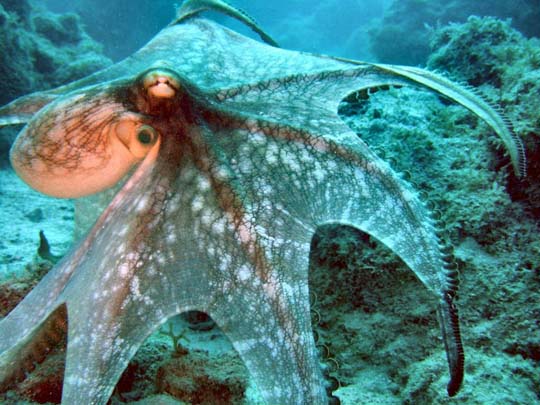
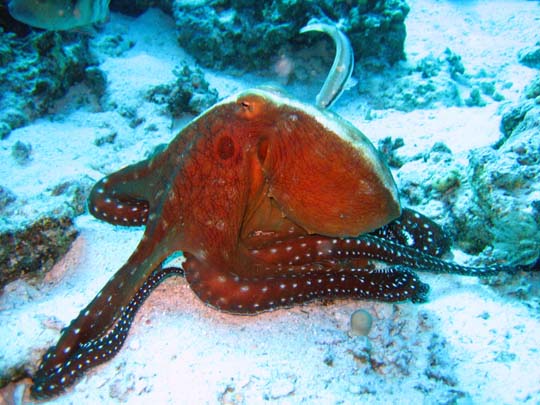
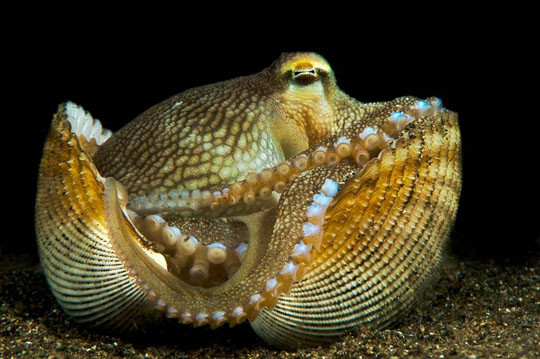

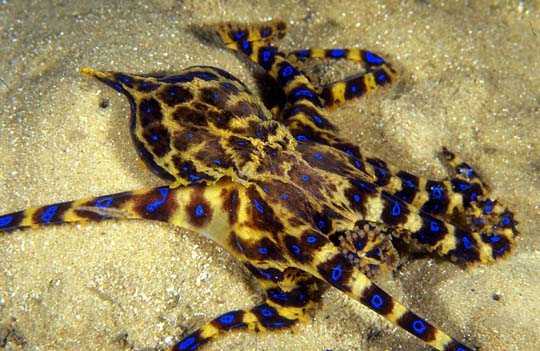
Among the octopuses there are very poisonous representatives, this is a blue-ringed octopus. Its poison is strong enough and its amount is enough to kill several people. At the same time, he behaves quite aggressively and the meeting with this octopus can end in disrepair the share of a diver or diver. By the way, the antidote for him has not yet been invented, it is known that the poison of the blue-necked octopus has a neuroparalytic effect on the victim. A striking feature of this type of octopus are bright circles of blue color throughout the body of the mollusk. It feeds on crustaceans, crabs, bivalves, while it punches a hole in the victim’s shell with its powerful beak and injects poisonous saliva, and then sucks the dissolved flesh, about the same as the spider does.
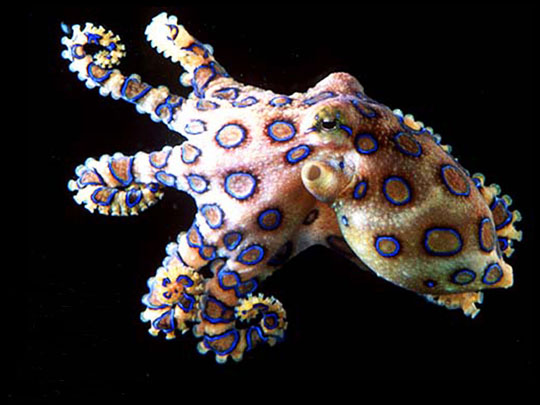
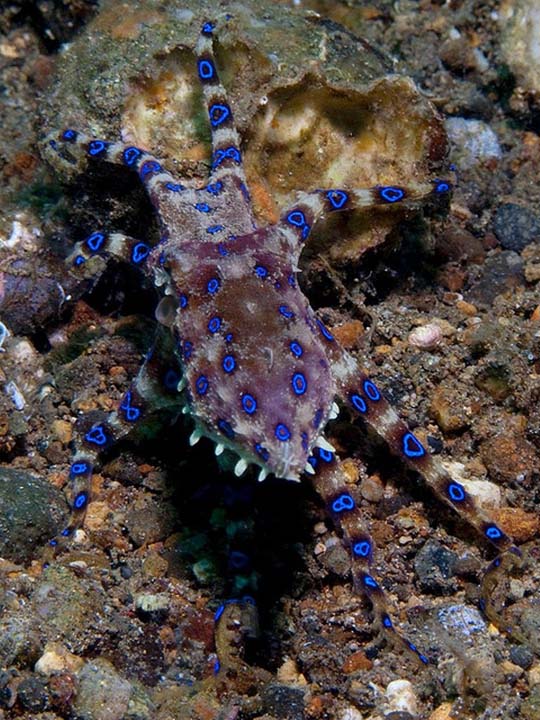
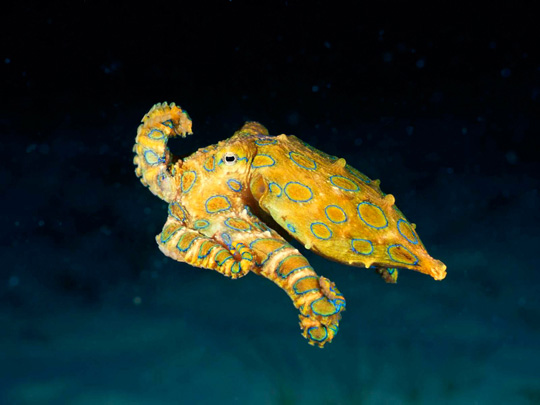
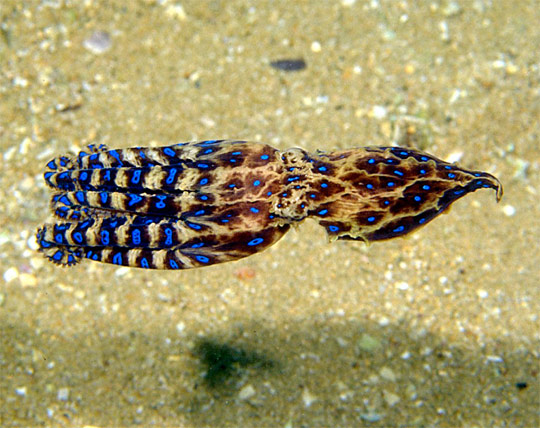

video
Sperm Whale vs. Colossal Squid (Computer Animation). Video:
The cuttlefish changes color. Video:
Cuttlefish on the hunt. Video:
Octopus. Video:
Octopus against shark. Video:
Squids, octopuses. Video:
Like, tell your friends.
Who is sea cuttlefish? Hearing this question, the image of some formless and incomprehensible animal immediately appears before your eyes. Although, perhaps, knowledgeable people would not talk like that about the cuttlefish, because these animals can be incredibly beautiful, and they cannot be called formless. Cuttlefish belong to the class of cephalopod mollusks.
Appearance of cuttlefish
The body of the animal is elongated, oval and slightly flattened. The main part of the body is the mantle. The role of the skeleton is performed by the inner shell - and this is a feature inherent only to cuttlefish. Head and torso - fused. The eyes are complex, they are located on the head of the mollusk. Even on the head of the cuttlefish there is something like a beak, this natural “adaptation” helps the mollusk very much during the extraction of food. Like many cephalopod mollusks, the cuttlefish has an ink sac.
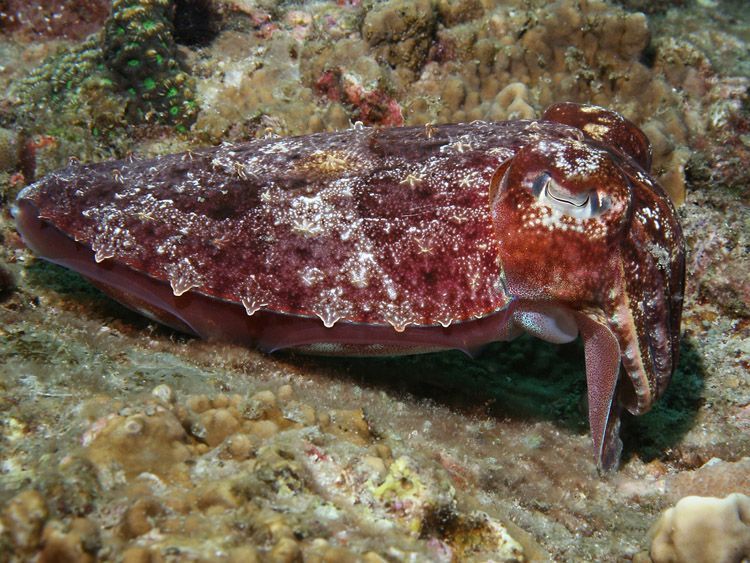 The broad-cuttlefish, or the wide-armored sepia (Sepia latimanus), is the largest species of these animals.
The broad-cuttlefish, or the wide-armored sepia (Sepia latimanus), is the largest species of these animals. The clam has eight legs, called tentacles. And each of these tentacles is literally littered with small suckers. On both sides of the body there are fins, with the help of which the animal makes swimming movements.
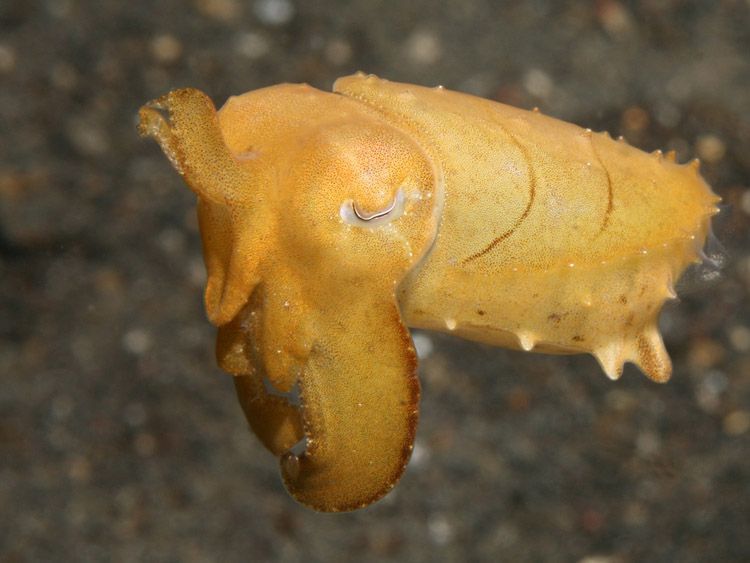
Body size of the animal is relatively small for cephalopods. The average adult cuttlefish is about 20 centimeters long. Larger cuttlefish is, but it is only representatives of certain species.
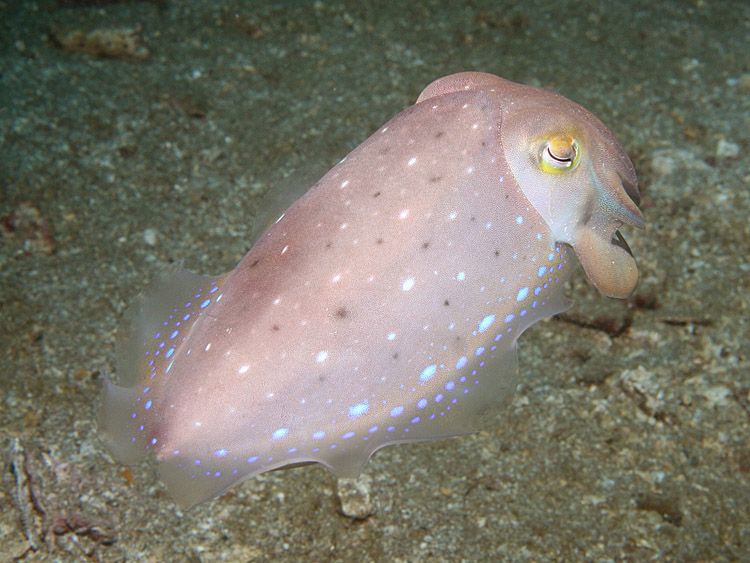
A remarkable feature of these mollusks is the ability to change the color of their body. Just like a chameleon! This process in cuttlefish is possible due to the chromatophore cells located on the skin.
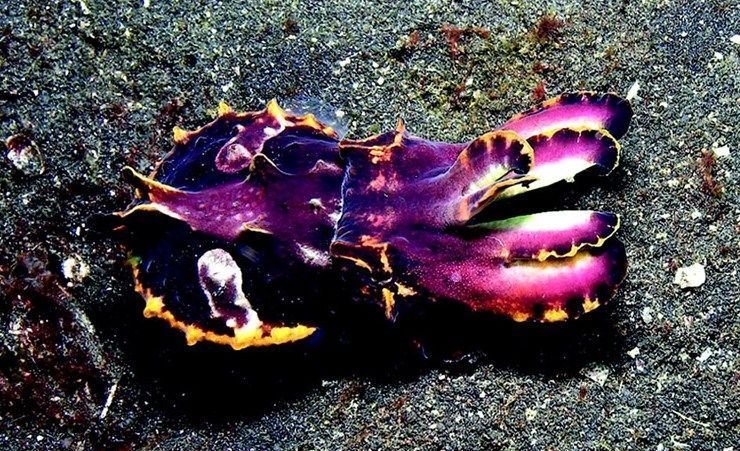
The most famous types of cuttlefish are:
- Common cuttlefish;
- Wide-cuttlefish (it is the largest of all cuttlefish: its length is about 1.5 meters and its weight is up to 10 kilograms);
- Painted cuttlefish (the most attractive among these mollusks, but poisonous);
- Striped cuttlefish (nicknamed "pajama cuttlefish" is also very poisonous);
- Pharaoh's cuttlefish.
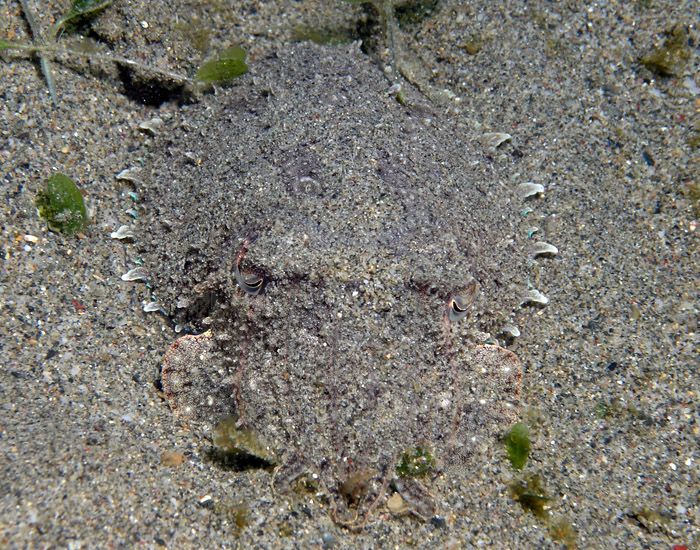
Habitat for cuttlefish
The places of residence of these mollusks are located in the tropical and subtropical zones of the seas washing the shores of Africa and Eurasia (part of the so-called “Old World”). However, striped cuttlefish was found even off the coast of Australia.
Lifestyle and behavior
Cuttlefish are solitary mollusks. And only in the marriage period, they can be seen in groups. Occasionally, these animals are ready to migrate somewhere, but the majority live in one place all their lives.

These mollusks are very cautious. They are very easy to scare. Usually behave calmly, prefer a leisurely movement under water. The depth of stay is small - these animals always try to stick to the coastline.
Scientists believe that cuttlefish are among the most intelligent representatives of invertebrates.
What does a cuttlefish eat
On the "dinner table" to the cuttlefish everything that is smaller in size and lives in the water falls. The main food for these unusual animals are fish, crabs, shrimp, worms, and other mollusks.

Breeding cuttlefish
As for the breeding of offspring, here the cuttlefish have their own unique feature: they breed only once in their entire life, after which they themselves die.
The marriage period is very interesting. Individuals gather in whole flocks and choose their partners. After the choice is made, the marriage game begins. Males and females shimmer with all the colors of the rainbow, thus showing their mood and relationship to a partner. The males gently stroke their "bride" with tentacles, seeking her favor.
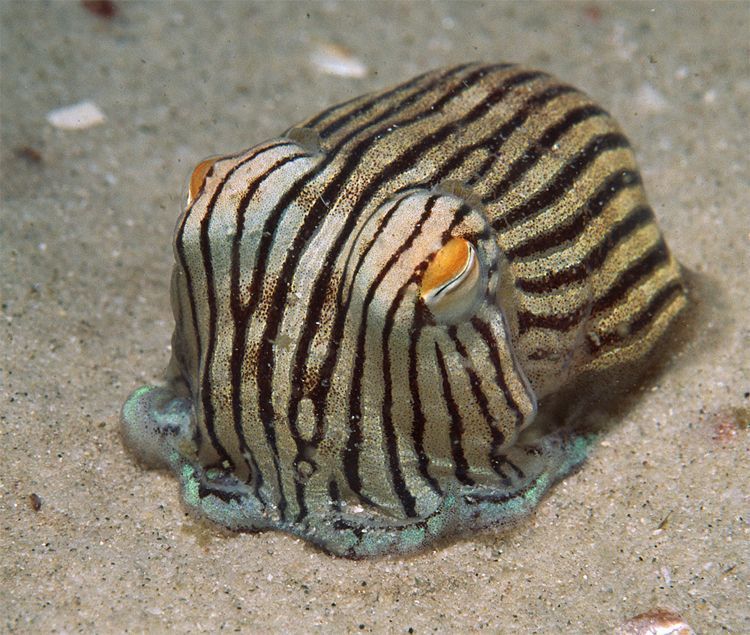 Striped cuttlefish (Sepioloidea lineolata) is another deadly poisonous species. It dwells in the waters of Australia, for its specific coloring in English it is also called pajama.
Striped cuttlefish (Sepioloidea lineolata) is another deadly poisonous species. It dwells in the waters of Australia, for its specific coloring in English it is also called pajama. With the help of male tentacles, male sex cells enter the body of the female individual. After some time, eggs are laid (the moment of fertilization also occurs). Egg clutches are attached to underwater plants and are often black in color. After spawning is over, adult cuttlefish die.
The cuttlefish babies are already fully formed, and they also grow very quickly.
The life span of cuttlefish is, on average, from one to two years.
Natural enemies
Lovers to hunt for these leisurely animals quite a lot. Especially love to eat cuttlefish stingrays, and. The number of these mollusks is also diminishing from human hunting for them.
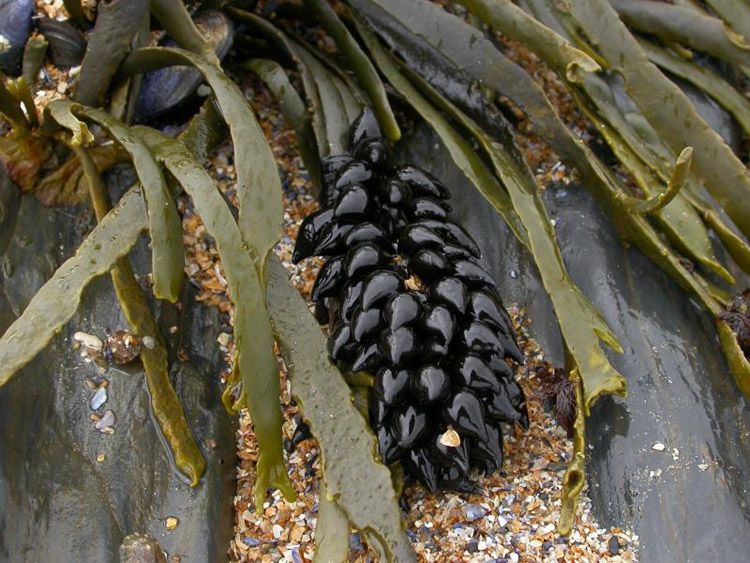
How is cuttlefish useful to people?
It is said that cuttlefish are quite widely used by man compared to other mollusks. They are used in food, crushed shell is added to the production of toothpaste, and the use of ink and generally known for a long time. In addition, some people get cuttlefish in domestic aquariums, despite some of the complexity of their captivity.
If you find an error, please highlight a piece of text and click Ctrl + Enter.
